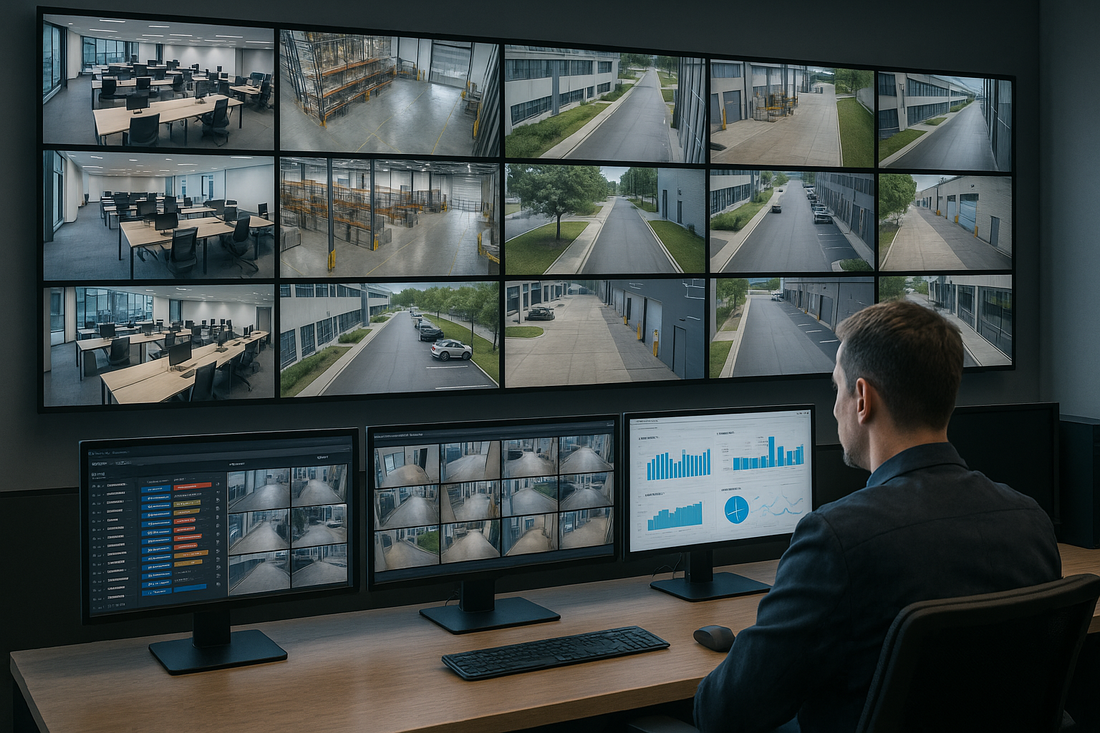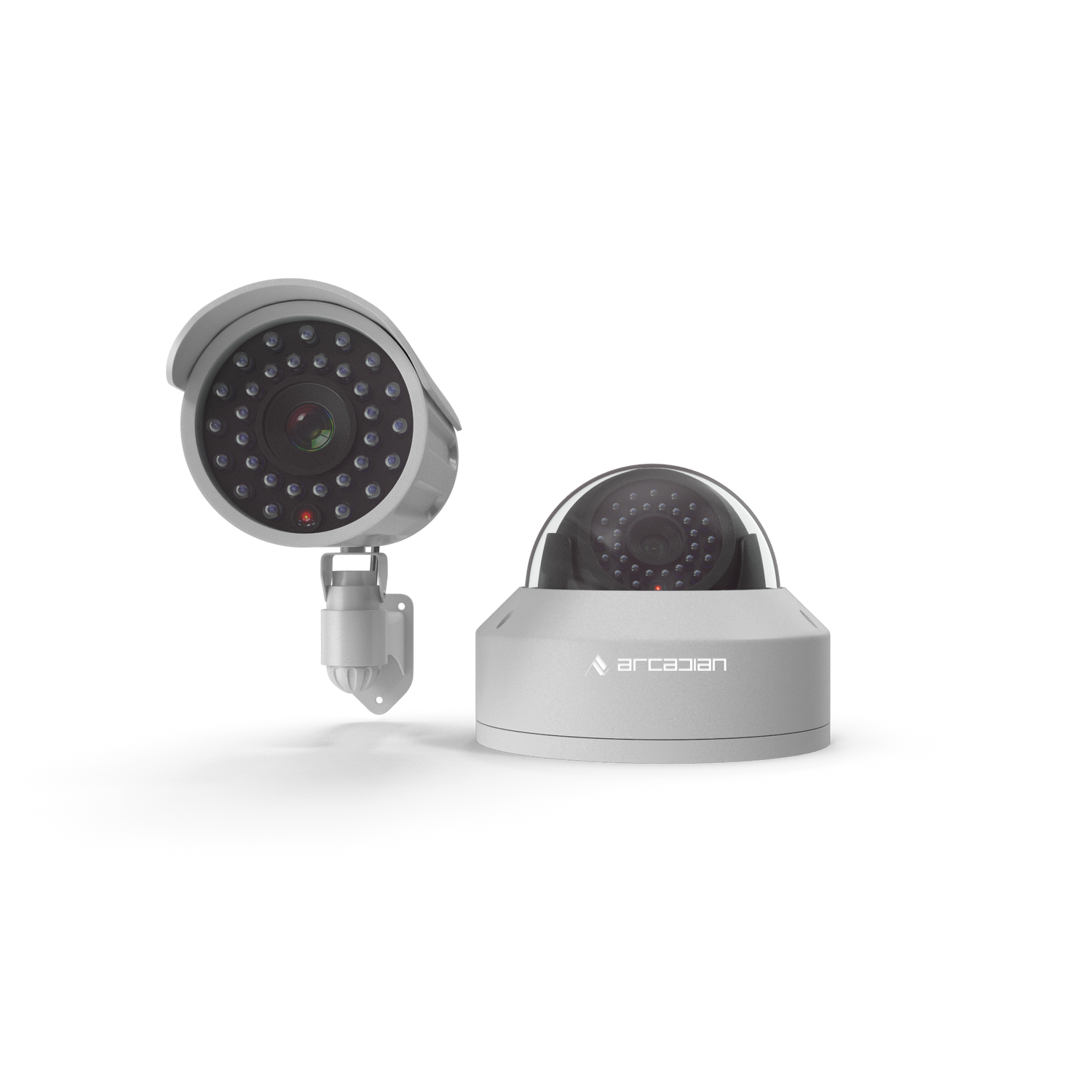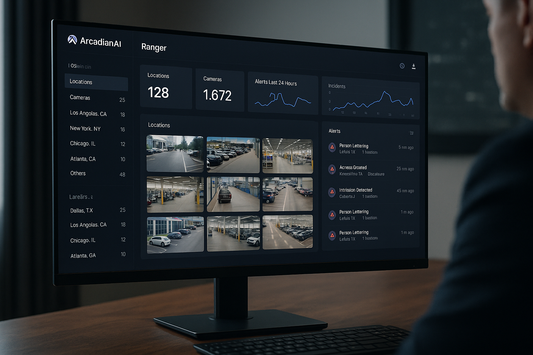The State of Video Monitoring in 2025: Market Reality, Main Players, and the False‑Alarm Fight (ArcadianAI Industry Review)
From stricter regulations to AI‑powered analytics, video monitoring is changing fast. This review maps the market, compares top platforms, and shows how ArcadianAI’s camera‑agnostic cloud and Ranger assistant reduce false alarms while improving ROI.

Introduction
The global video surveillance + VSaaS market keeps expanding—2024 estimates place the market around $74B with a path to ~$148B by 2030 as cloud and AI mature. (Grand View Research) At the same time, VSaaS on its own is forecast to grow ~18% CAGR to 2030, reflecting a rapid shift from NVRs to cloud and hybrid models. (Grand View Research)
ArcadianAI is built for this shift: a cloud‑native, camera‑agnostic platform with our AI assistant Ranger to triage events, cut false alarms, and speed investigations—without locking you into one camera brand. We’ll benchmark ArcadianAI against leaders like Verkada, Genetec, Milestone, Eagle Eye Networks, and Rhombus throughout this review.
Quick summary / key takeaways
-
Cloud + AI are now the default direction.
-
False alarms drive policy changes and costs.
-
Compliance (NDAA/FCC, UK/AU removals, India rules) is reshaping buying.
-
Unified platforms vs. point tools: consolidation wins.
-
ArcadianAI + Ranger: fewer false alarms, faster ROI.
Background & relevance (fresh 2024–2025 facts)
-
The broader video surveillance market is projected to ~$88–148B by 2030 depending on methodology; both ranges point to sustained double‑digit growth in cloud/AI. (MarketsandMarkets, Grand View Research)
-
Policy pressure is real: the FCC (Nov 2022) halted new U.S. authorizations for equipment from Hikvision/Dahua and others, tightening federal procurement and compliance posture for many buyers. (FCC Docs)
-
UK plans full removal of Chinese‑made surveillance at sensitive sites by April 2025; Australia removed similar equipment from defense/government buildings in 2023. (Reuters)
-
India (Apr 9, 2025) began mandatory government‑lab testing of internet‑connected CCTV hardware/software (including source code in some cases), impacting supply chains and deployment timelines. (Reuters)
Core topic exploration
How is the market segmented in 2025?
-
On‑prem VMS: e.g., Genetec Security Center (unified video, access, ALPR) and Milestone XProtect (open‑platform VMS). (Genetec, Milestone Systems)
-
Cloud VMS / VSaaS: e.g., Eagle Eye Networks (cloud VMS, bridges/CMVRs), Rhombus (cloud‑managed cameras + console). (Eagle Eye Networks, Rhombus)
-
Vertical specialists: e.g., ALPR networks such as Flock Safety—fast‑spreading but with ongoing privacy debates and policy scrutiny. (Electronic Frontier Foundation, Congress.gov)
-
ArcadianAI: cloud‑native, camera‑agnostic ingest; AI assistant Ranger for triage, search, workflows; open integrations to meet today’s compliance landscape.
False alarms: still the industry’s costliest problem
False alarms waste time, erode trust, and trigger “verified response” policies. Milwaukee PD adopted verified response after ~97% of ~30,000 yearly burglar alarms were false; today it dispatches to far fewer alarms, prioritizing verified ones (video/audio/eyewitness). (City of Milwaukee)
ArcadianAI + Ranger:
-
Multi‑signal verification (object/person/vehicle, dwell, trajectory, schedule, access events).
-
Context prompts in Ranger to explain why an alert is high‑confidence.
-
Policy packs tuned for verified response jurisdictions to cut dispatch noise.
Related trend: alarm standards and policies (e.g., IACP model ordinance, TMA standards, and city verified‑response rules) continue to push toward evidence‑backed dispatch. (IACP, tma.us)
Security, privacy, and AI accuracy
-
Cloud era breach lessons: The 2021 Verkada incident led to 2024 FTC action requiring stronger security programs—buyers now expect vendor security transparency as table stakes. (Federal Trade Commission)
-
Face recognition differentials: NIST’s ongoing FRTE/FRVT work shows demographic error variations persist and must be managed with controls and policy (thresholding, QA, human‑in‑the‑loop). (NIST Pages)
ArcadianAI approach: we default to privacy‑preserving analytics, role‑based access, audit trails, and controls to avoid overreliance on a single model output—Ranger explains confidence and recommends verification steps.
Regulation and supply chain risk = procurement change
-
U.S.: No new FCC equipment authorizations for certain Chinese vendors; buyers are migrating to NDAA‑compliant hardware and audited software supply chains. (FCC Docs)
-
UK & Australia: government‑site removals/limits reset expectations for public‑sector bids and many private buyers. (Reuters)
-
India: Apr 2025 testing regime affects both foreign and domestic camera makers; project timelines and SKUs may be delayed pending certification. (Reuters)
ArcadianAI: camera‑agnostic ingest lets you mix compliant hardware (Axis, Hanwha, etc.) without forklift upgrades—and pivot quickly if regional rules change.

Comparisons & use cases
Who does what (and how ArcadianAI differs)
| Capability | ArcadianAI (with Ranger) | Genetec (Security Center) | Milestone (XProtect) | Eagle Eye Networks | Rhombus |
|---|---|---|---|---|---|
| Cloud‑native | ✅ Cloud with hybrid edges | Hybrid/SaaS & on‑prem options | Primarily on‑prem VMS (with cloud options) | ✅ Cloud VMS | ✅ Cloud VMS |
| Camera‑agnostic | ✅ Broad ONVIF/IP support | ✅ Wide device support | ✅ Wide device support | ✅ Broad compatibility via bridges | Primarily Rhombus devices |
| AI triage & false‑alarm filtering | ✅ Built‑in + Ranger workflow | Add‑ons/integrations | Add‑ons/integrations | Built‑in analytics | Built‑in analytics |
| Unified security (video + access + ALPR) | ✅ Integrations + APIs | ✅ Unified platform (video/access/ALPR) | Video‑first; partner add‑ons | Video‑first; partner add‑ons | Video‑first; add‑ons |
| Compliance agility (NDAA/FCC, UK/AU/IN) | ✅ Camera‑agnostic swap path | ✅ Hardware choice | ✅ Hardware choice | ✅ Cloud + broad cam support | HW‑centric (own cams) |
References for platform positioning: Genetec unified platform, Milestone XProtect variants, Eagle Eye cloud VMS & bridges, Rhombus cloud console. (Genetec, Milestone Systems, Eagle Eye Networks, Rhombus)
ROI snapshot: guard posts vs. AI‑verified monitoring
-
Median U.S. security guard wage (May 2024): $38,370/year (~$18.45/hr). A 24/7 single post = ~$161,600/year in wages alone (benefits/overhead not included). (Bureau of Labor Statistics)
-
ArcadianAI model: replace some overnight posts with AI‑verified remote monitoring, keep roving guards for response. Typical outcome: fewer dispatches (verified‑response friendly) + 24/7 coverage + audit trails.
Example: Replace 1 overnight post (12 hours/night * 365) → ~4,380 guard hours/year. At ~$18.45/hr, ~$80.8k wage savings before benefits/overhead; reinvest in mobile response, upgrades, and training. (Bureau of Labor Statistics)
Sector use cases
-
Logistics/warehousing: Ranger filters animal/shadow motion, escalates only person/vehicle intrusions after hours—fits jurisdictions requiring verified response. (City of Milwaukee)
-
Retail multi‑site: Centralized cloud search across locations; export reporter‑ready clips during incidents; avoid hardware sprawl. Market growth in VSaaS underscores this shift. (Grand View Research)
-
Public sector/education: NDAA/FCC‑aware procurement; swap restricted gear on a rolling basis; UK/AU precedents guide policy. (FCC Docs, Reuters)
-
Mobility & ALPR: If you’re evaluating networked ALPR, weigh the privacy and policy risks reported by civil‑society groups and state reviews. ArcadianAI focuses on site‑owned data and strict retention. (Electronic Frontier Foundation, vscc.virginia.gov)
Common questions (FAQ)
What’s the difference between VMS and VSaaS?
VMS is traditionally on‑prem software; VSaaS is cloud‑hosted video management/storage/analytics. Many deployments are now hybrid.
How do verified‑response rules affect me?
In some cities, police prioritize or require video/audio/eyewitness confirmation before dispatch. Design your alarms to provide evidence. (City of Milwaukee)
Are face analytics “set and forget”?
No. NIST shows demographic error variations; keep human‑in‑the‑loop and clear SOPs. (NIST Pages)
Which vendors are “most secure”?
Look for transparent security programs, audits, encryption, SSO/MFA, and breach history/response (e.g., 2024 FTC actions raised the bar for some cloud vendors). (Federal Trade Commission)
Will regulations affect camera choice?
Yes. U.S. FCC rules, UK/AU removals, and India’s 2025 testing can limit or delay certain hardware. Choose camera‑agnostic platforms. (FCC Docs, Reuters)
Conclusion & CTA
The 2025 reality: cloud + AI are winning, verified response is spreading, and compliance rules are reshaping hardware choices. ArcadianAI’s camera‑agnostic cloud and Ranger reduce false alarms, simplify audits, and accelerate ROI—without locking you in.
See ArcadianAI in Action → Get Demo – ArcadianAI
Security Glossary (2025 Edition)
AI Alerts — Automated notifications from AI analytics (person/vehicle, loitering, line‑cross, etc.) to reduce noise and speed response.
ALPR (Automated License Plate Recognition) — Tech that reads plates to flag hotlists; widely used, often debated for privacy and retention policies. (Congress.gov)
AVS‑01 (TMA) — Alarm Validation Scoring standard used by monitoring centers to grade alarms for dispatch priority. (tma.us)
Camera‑Agnostic — A platform that works with many IP/ONVIF‑compliant cameras so buyers aren’t locked to a single brand.
Cloud VMS / VSaaS — Video management, storage, and analytics delivered from the cloud; typically subscription‑based with optional edge buffering. (Grand View Research)
FCC Secure Equipment Rules (U.S.) — 2022 FCC action blocking new equipment authorizations for certain vendors (e.g., Hikvision, Dahua) over security risks. (FCC Docs)
False Alarm — An alert without a real incident; a major cost driver behind verified‑response policies in many cities. (City of Milwaukee)
FRTE/FRVT (NIST) — Ongoing NIST face recognition evaluations; include studies of demographic error differentials and video performance. (NIST Pages)
Hybrid Storage — Combining on‑prem buffering (appliances/SD) with cloud retention to manage bandwidth and resiliency. (Eagle Eye Networks)
NDAA Compliance (U.S.) — Federal procurement restrictions (e.g., Section 889) impacting some vendors; often paired with FCC authorization bans. (FCC Docs)
Remote Video Monitoring (RVM) — Live, off‑site monitoring by trained operators using AI‑filtered events to verify incidents before dispatch.
Ranger (ArcadianAI) — An AI assistant embedded in ArcadianAI for triage, search, and explainable workflows that reduce false alarms.
Unified Platform — Single pane for video, access control, ALPR, comms, and incident management (e.g., Genetec Security Center). (Genetec)
Verified Response — Police response only when alarms are video/audio/eyewitness verified, reducing dispatch to false alarms. (City of Milwaukee)
VMS (Video Management System) — Software that records, manages, and searches camera streams, historically on‑prem but increasingly hybrid/cloud.
VSaaS (Video Surveillance as a Service) — Subscription model for cloud‑hosted video storage/management/analytics, growing at ~18% CAGR. (Grand View Research)

Security is like insurance—until you need it, you don’t think about it.
But when something goes wrong? Break-ins, theft, liability claims—suddenly, it’s all you think about.
ArcadianAI upgrades your security to the AI era—no new hardware, no sky-high costs, just smart protection that works.
→ Stop security incidents before they happen
→ Cut security costs without cutting corners
→ Run your business without the worry
Because the best security isn’t reactive—it’s proactive.







